Over the past few years, there have been intriguing new developments for nematode management in cotton. Reniform nematode and southern root-knot nematode are the major nematode pests of cotton in Florida and the Southeast. Nematode management typically relies on a combination of crop rotation, nematicide application, and use of resistant cultivars. Cotton cultivars resistant to southern root-knot nematode have been available for a number of years, but in the past, no cultivars resistant to reniform nematode have been available. However, in 2021, cotton cultivars with dual resistance to both root-knot nematode and reniform nematode became available. Independent testing of new cultivars and products is always an important part of product evaluation, so in 2021 we evaluated two of these new cultivars in small plot trials for the first time. The cultivars evaluated were Deltapine 2141NR B3XF (DP 2141NR) and Phytogen 443 W3FE (PHY 443).
DP 2141NR was evaluated in two trials, the first with reniform nematode at the North Florida Research and Education Center (NFREC) near Quincy, Florida. This trial was part of the National Cotton Council Nematode Committee uniform testing that was conducted in many cotton-producing states. In that trial, five in-furrow or seed coating nematicide treatments were implemented with both DP 1646 (nematode susceptible) and DP 2141NR (resistant). The trial was planted June 11 and harvested December 1. Yield and nematode counts from mid-season and harvest are reported here.
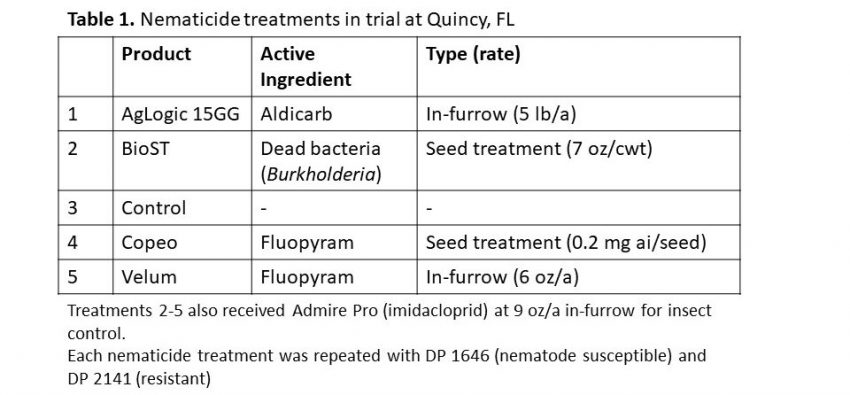
–
In the first trial, the resistant variety (DP 2141NR) greatly reduced reniform nematode infection at midseason (Figure 1). AgLogic also reduced infection compared to other nematicide treatments, particularly under the susceptible cultivar (Figure 1). Nematode control at mid-season is often the most important timing for nematode management impacts on cotton yield, particularly when evaluating nematicides. Final reniform nematode soil counts were also reduced by the resistant cultivar, but nematicides did not affect final reniform nematode counts (Figure 2). Final nematode soil counts show the longer-term benefits of products for nematode management as these counts determine reniform nematode pressure for the next season.
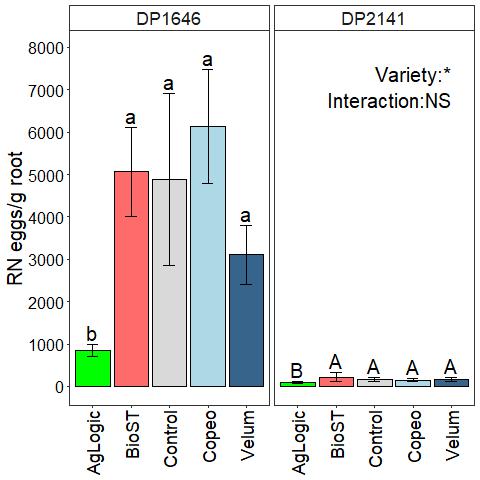
Figure 1. At midseason (38 days after planting), reniform nematode counts in roots were greater for DP 1646 (susceptible) than DP 2141NR (resistant). Within each cultivar, AgLogic also had significantly lower reniform nematode infection than other nematicide treatments (indicated by letters).
–
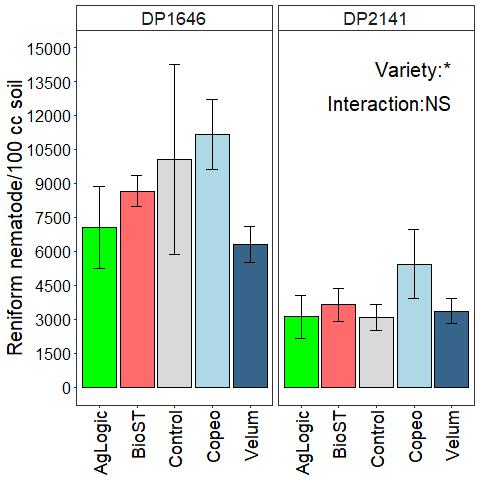
Figure 2. Final reniform nematode soil counts were significantly higher for DP 1646 (susceptible) than DP 2141NR (nematode resistant). Nematicide treatments did not affect final reniform nematode soil counts.
–
Nematode control by variety and nematicides affected crop growth. Throughout the first trial, the nematode-resistant cotton (DP 2141NR) had more vegetative growth than the susceptible cultivar (Figure 3). This was quantifying and confirmed with visual vigor assessments (data not shown). However, crop vigor did not translate to cotton yield, as the susceptible cultivar (DP 1646) had approximately 100 lb lint/a greater yield than DP 2141NR (Figure 4). Subjectively, greater vegetative growth with DP 2141NR may have actually slowed yield. Near the end of the year, DP 2141NR had a fuller canopy with less senescence. However, there also seemed to be more hardlock, less boll opening, and a more dispersed fruit set with DP 2141NR than DP 1646. Whether this was due to agronomic characteristics of DP 2141NR or the unique circumstances of this trial remain to be seen. From other states that conducted the same trial under reniform nematode pressure, yield of the two cultivars was very similar on average.
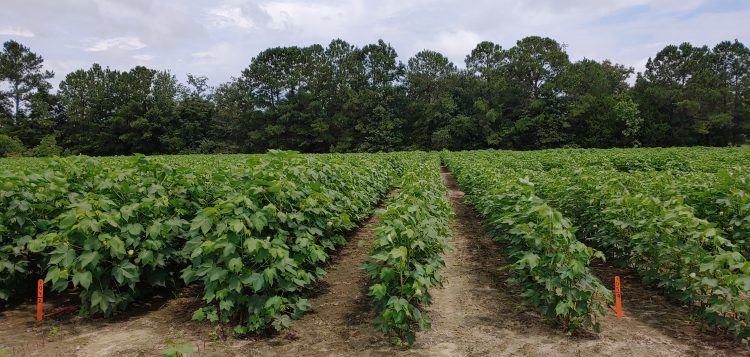
Figure 3. Nematode-resistant cultivar DP 2141NR (left) was more vigorous than susceptible cultivar DP 1646 (right) throughout the trial at NFREC-Quincy. Note differences in height and canopy closure in this picture at 74 days after planting. Photo credit: Zane Grabau
–
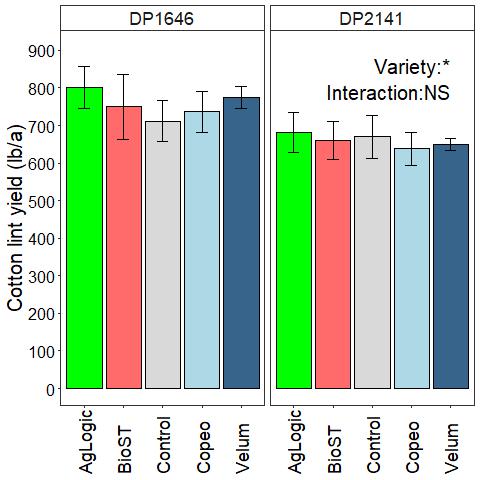
Figure 4. Cotton yield was significantly greater for DP 1646 (susceptible) than DP 2141NR (nematode resistant). Nematicide treatments did not significantly affect yield.
–
The second trial assessing DP 2141NR was conducted at the NFREC – -Suwannee Valley, near Live Oak, Florida, with southern root-knot nematode the primary pest. The three treatments presented here are (1) untreated control of DP 1646 without nematicide, (2) 1646 with Velum at 6.5 oz/a, and (3) DP 2141NR without nematicide. The trial was planted May 28 and harvested November 3. Data collection was similar to the previous trial except that root galling at harvest was also assessed because that is an important measure of cumulative root-knot nematode damage.
In the trial at Live Oak, either Velum or DP 2141 was effective at reducing midseason root-knot nematode infection (Figure 5 left). The resistant cultivar was more effective for season-long control, reducing final soil nematode counts and galling (Figures 5 and 6). However, none of the treatments significantly affected yield (Figure 6). Lack of yield return may reflect environmental conditions (note low yield) and relatively moderate nematode pressure rather than lack of product efficacy.
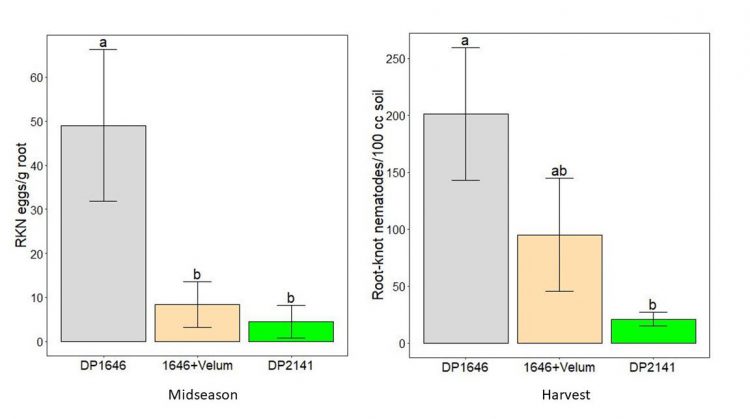
Figure 5. Southern root-knot nematode root infection at midseason (39 days after planting, left) and soil counts at harvest (right) as affected by resistant cultivar (DP 2141) and Velum nematicide. Trial at NFREC-Suwannee Valley.
–
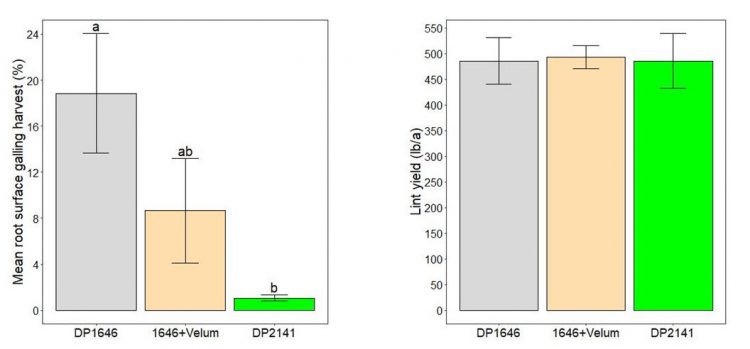
Figure 6. Root surface galling and cotton yield as affected by resistant cultivar (DP 2141) and Velum nematicide. Trial at NFREC-Suwannee Valley.
–
A final trial was conducted at the NFREC – Quincy, this time assessing Phytogen cultivars under reniform nematode pressure. The treatments presented here are (1) untreated control: nematode susceptible cultivar PHY 444 without nematicide, (2) PHY 444 with Velum at 6.84 oz/a, and (3) nematode resistant PHY 443. Data collection was the same as the first Quincy trial, with planting June 2 and harvest November 8. PHY 443 resistant cultivar, but not Velum nematicide, reduced root infection by reniform nematode at mid-season and final reniform nematode soil counts (Figure 7). Nematode management resulted in yield benefits as yield was substantially greater for the resistant cultivar PHY 443 than the susceptible PHY 444 with or without Velum nematicide (Figure 8).
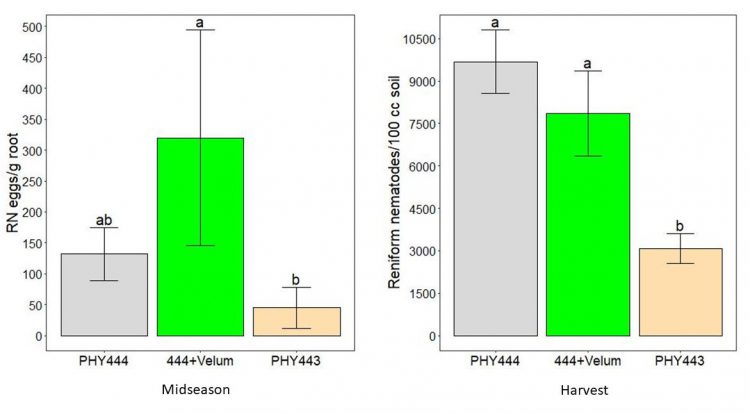
Figure 7. Resistant cultivar (PHY 443), but not velum nematicide reduced midseason reniform nematode cotton root infection (left) and final reniform nematode soil counts (right).
–
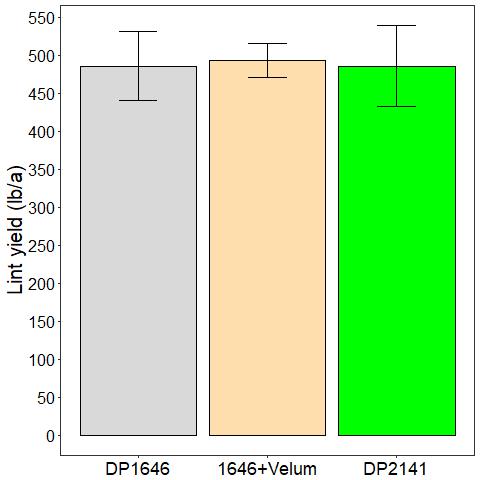
Figure 8. Resistant cultivar (PHY 443) increased cotton lint yield compared to nematode susceptible cultivar. Velum nematicide did not increase cotton yield.
–
More years of data will be needed to fully evaluate these cultivars, particularly for yield potential. Some main points to take away from this initial evaluation of these cultivars are:
- Both Phytogen 443 and Deltapine 2141NR did have good resistance to reniform nematode. Fewer reniform nematodes infected these cultivars and they also reduced final soil reniform nematode counts more than a susceptible cultivar, which is useful in managing reniform nematode for following crops.
– - More research is needed on yield of these resistant cultivars, particularly under nematode pressure. From initial data, even under severe reniform nematode pressure, DP 1646 may have slightly better yield than DP 2141NR. Phytogen 443 was clearly superior to a susceptible cultivar (PHY 444) under severe reniform nematode pressure.
– - DP 2141NR was also effective for southern root-knot nematode management. PHY 443 was not tested against southern root-knot nematode in these trials.
– - In summary, these nematode resistant cultivars, look to be promising tools for nematode management in cotton production.
–
For more information on nematode management in Florida cotton, see the following UF/IFAS publication:
Management of Plant-Parasitic Nematodes in Florida Cotton Production
- Salibro: A Recently-Registered Conventional Nematicide for Select Horticulture Crops - March 7, 2025
- What Cotton Cultivars have Resistance or Tolerance to Southern Root-knot and Reniform Nematode? - February 28, 2025
- How Well Do Root-Knot Nematode Resistant Peanut Cultivars Perform in Florida? - February 14, 2025
